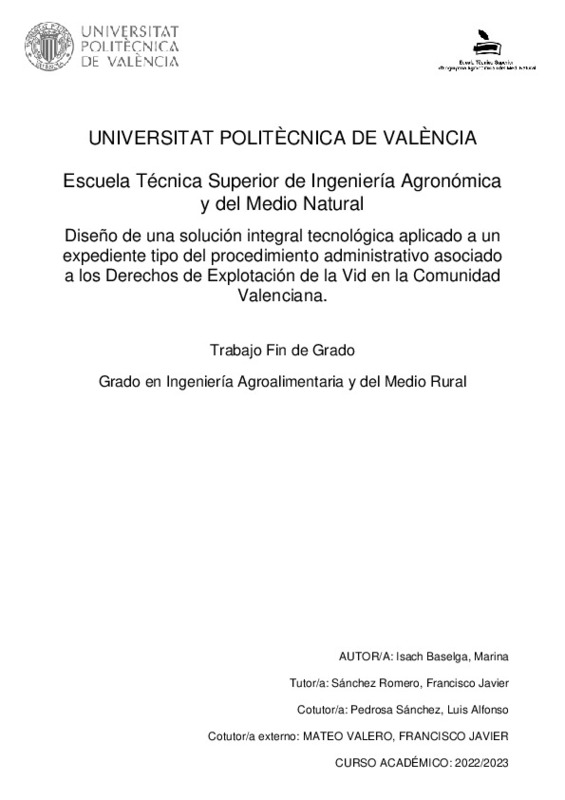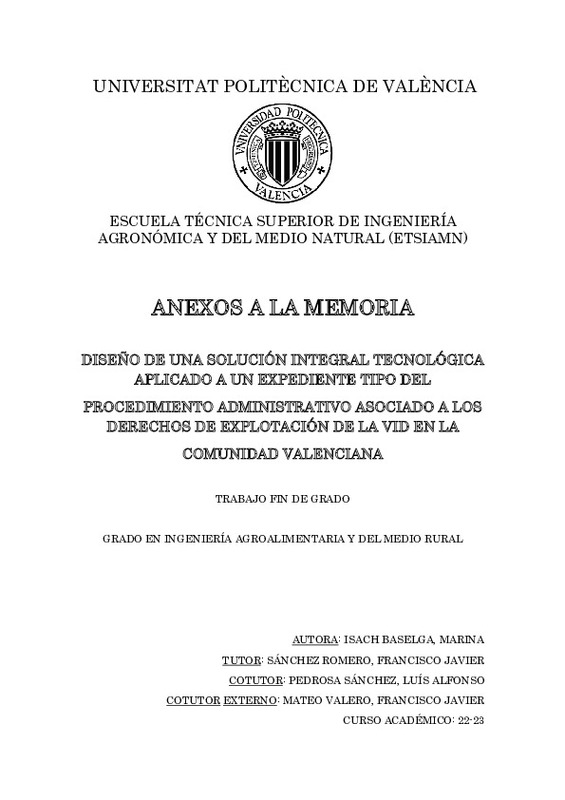|
Resumen:
|
[ES] Las Administraciones Públicas tienen la competencia para regular la producción agrícola y ganadera a la vez que gestionar el conjunto de ayudas al sector. De esto surge la necesidad de mantener un conocimiento actualizado ...[+]
[ES] Las Administraciones Públicas tienen la competencia para regular la producción agrícola y ganadera a la vez que gestionar el conjunto de ayudas al sector. De esto surge la necesidad de mantener un conocimiento actualizado de todas las explotaciones, tanto en cuanto a la naturaleza de la explotación como el recinto y localización donde se produce la actividad.
Particularmente, la producción de vino de vinificación está regulada por normativa europea en relación con las variedades, la superficie y las cantidades a producir limitadas por los Derechos de Explotación de la vid. Esta normativa europea se traspone a normativa nacional, por lo que existe la necesidad de conocer, controlar y gestionar las explotaciones vitivinícolas. En consecuencia, actualmente hay presente un conjunto de procesos administrativos paralelos al cultivo agronómico y explotación industrial de la vid, que sirven de canal de comunicación entre los explotadores (o sus representantes) y la Administración Pública, delegada en las Autonomías, que ostentan el mandato de las normas nacionales.
La Conselleria de Agricultura, Desarrollo Rural, Emergencia Climática y Transición Ecológica, a través de la Dirección General de Tecnologías de la Información y Comunicaciones, ambas pertenecientes a la Generalitat Valenciana han contratado los servicios para el rediseño de los procesos y sistemas de gestión de explotaciones vitivinícolas, incluyendo el desarrollo informático de una nueva aplicación -VINYA- con el objeto de digitalizar todo el ciclo de vida de gestión de explotaciones agrarias en el sector.
Ello supone la creación de un nuevo Registro Vitivinícola de la Comunidad Valenciana RVCV conteniendo información, cualitativa, cuantitativa y geográfica, así como el conjunto de actuaciones posibles: trámites, procedimientos, formularios, registros, emisión de documentos, etc., de acuerdo con los principios de necesidad y eficacia, que permita ejercer su competencia en control de las explotaciones.
Debido a la inmensidad del ecosistema administrativo alrededor del sector vitivinícola, el tema del presente TFG se centrará en el proceso administrativo del expediente tipo Comunicación de Plantación (en adelante, CPL), el cual regula la gestión integral desde la solicitud de plantación de cepas para vino previamente a su plantación, hasta su resolución. Este TFG analiza las necesidades desde los puntos de vista regulatorio, administrativo, e incluso de la administración electrónica, de todos los actores involucrados: funcionarios, explotadores, etc.; con el objeto de definir los requerimientos y diseño funcional de la herramienta VINYA.
Los objetivos ODS más alineados con la finalidad de la solución tecnológica estudiada son: ODS N.º 8, 16 y 2 -en ese orden de importancia- siendo estos: 8-Trabajo decente y crecimiento económico, 16-Paz, justicia e instituciones sólidas y 2-Hambre cero.
[-]
[EN] The Public Administrations have the competence to regulate agricultural and livestock production as well as to manage all the aids to the sector. From this arises the need to support an updated knowledge of all farms, ...[+]
[EN] The Public Administrations have the competence to regulate agricultural and livestock production as well as to manage all the aids to the sector. From this arises the need to support an updated knowledge of all farms, both in terms of the nature of the farm and the enclosure and location where the activity takes place.
In particular, the production of wine for vinification is regulated by European regulations in relation to the varieties, the surface area and the quantities to be produced, which are limited by the vine exploitation rights. These European regulations are transposed into national regulations, which means that there is a need to know, control and manage wine-growing holdings. As a result, there is currently a set of administrative processes parallel to the agronomic cultivation and industrial exploitation of the vine, which serve as a communication channel between the operators (or their representatives) and the Public Administration, delegated to the Autonomous Regions, which have the mandate of the national regulations.
The Regional Ministry of Agriculture, Rural Development, Climate Emergency and Ecological Transition, through the Directorate General of Information Technology and Communications, both belonging to the Generalitat Valenciana, have contracted the services for the re-design of the processes and management systems of wine farms, including the computer development of a new application -VINYA- with the aim of digitising the entire life cycle of farm management in the sector.
This involves the creation of a new Valencian Community Wine Register (RVCV) containing qualitative, quantitative and geographical information, as well as all possible actions: formalities, procedures, forms, registers, issuing documents, etc., in accordance with the principles of necessity and efficiency, which will enable it to exercise its competence in farm control.
Due to the immensity of the administrative ecosystem surrounding the wine sector, the subject of this dissertation will focus on the administrative process of Communication for Planting (hereinafter, CPL), which regulates the integral management from the application for the planting of vines for wine prior to their planting, to their resolution. This TFG analyses the needs from the regulatory, administrative, and even e-government points of view of all the actors involved: civil servants, operators¿; with the aim of defining the requirements and functional design of the VINYA tool.
The SDG objectives most aligned with the purpose of the technological solution studied. This are: SDG No. 8, 16 and 2 -in that order of importance- these being: 8-Decent work and economic growth, 16-Peace, justice and solid institutions, and 2-Zero hunger.
[-]
|








